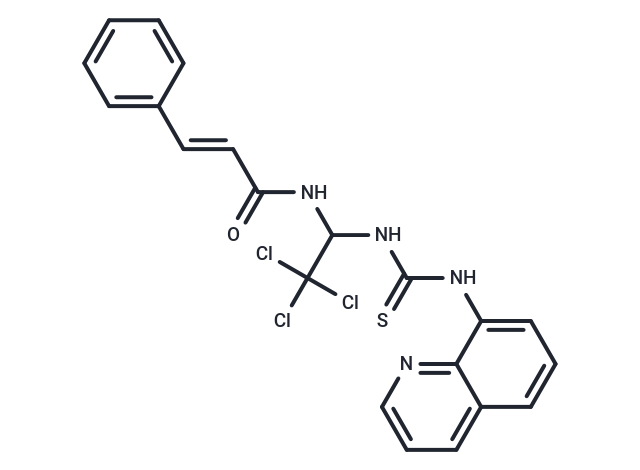Shopping Cart
Remove All Your shopping cart is currently empty
Your shopping cart is currently empty
Salubrinal, a phosphatases (PP1) inhibitor(IC50=1.7 μM), exhibits function on the eukaryotic translation initiation factor 2 subunit (eIF2α).

| Pack Size | Price | USA Warehouse | Global Warehouse | Quantity |
|---|---|---|---|---|
| 2 mg | $35 | In Stock | In Stock | |
| 5 mg | $56 | In Stock | In Stock | |
| 10 mg | $85 | In Stock | In Stock | |
| 25 mg | $166 | In Stock | In Stock | |
| 50 mg | $288 | In Stock | In Stock | |
| 100 mg | $490 | In Stock | In Stock | |
| 500 mg | $1,090 | Inquiry | Inquiry | |
| 1 mL x 10 mM (in DMSO) | $62 | In Stock | In Stock |
| Description | Salubrinal, a phosphatases (PP1) inhibitor(IC50=1.7 μM), exhibits function on the eukaryotic translation initiation factor 2 subunit (eIF2α). |
| Targets&IC50 | PP1:1.7 μM |
| In vitro | In a murine model of corneal infection, Salubrinal inhibits HSV replication and lowers viral titers in eye swabs of infected animals. Intraventricular administration of Salubrinal significantly alters the homeostatic sleep response. |
| In vivo | Salubrinal (EC50=15 μM) inhibits tunicamycin-induced ER stress and subsequent apoptosis in a dose-dependent manner. Additionally, Salubrinal (IC50=3 μM) hampers HSV replication by inhibiting the dephosphorylation of eIF2α. In C12 cells, it downregulates cyclin D1 while upregulating GADD34 and CHOP. |
| Kinase Assay | Phosphatase activities are determined on immunoprecipitates of the phosphatases. Briefly, 2×106 K562 cells are treated for 18 hr with Salubrinal (20 μM), PSI (10 nM), the combination of both drugs or okadaic acid (100 nM). After washing with PBS, cells are lysed for 15 min on ice either in PP1LB (for determination of PP1γ-activity; 20 mM Tris-HCl, pH 7.5, 1% Triton X-100, 10% glycerol, 132 mM NaCl, Roche complete protease inhibitor ) or in RIPA (for PP2A), supplemented with Roche complete protease inhibitor). Cell lysates containing 500 μg (PP1γ) or 300 μg (PP2A) protein are immunoprecipitated overnight at 4°C with 2-3 μg of the appropriate antibodies and then incubated with Protein A-Sepharose. Immunoprecipitates are washed three times in lysis buffer, followed by resuspension in phosphatase assay buffer (PP2A: 20 mM Tris-HCl, pH7.5, 0.1 mM CaCl2; PP1γ: 50 mM Tris HCl pH 7.0, 0.2 mM MnCl2, 0.1 mM CaCl2, 125 μg/mL BSA, 0.05% Tween 20), supplemented with 100 μM 6,8-difluoro-4-methyl-umbelliferyl phosphate (DiFMUP). Precipitates are allowed to react with substrate for 1 hr at 37°C on an Eppendorf Thermoshaker, centrifuged and DiFMU fluorescence is measured on a BioTek Lambda Fluoro 320 microplate reader (360 nmex/460 nmem). Phosphatase activities are given as percent change relative to the control (DMSO treated cells)[1]. |
| Cell Research | PC12 cells are plated in 384-well plates at 5000 cells per well in 40μL phenol red-freemedium containing 3μg/ml Tm to induce ER stress. 100 nL of the DiverSet E (5 mg/mlin DMSO) or National Cancer Institute's (NCI) Structural Diversity set and Open Collections (10 mM in DMSO) (NCI) are added to the wells by robotic pin transfer. After 48 hours, cell viability is assessed using a luminescence-based ATP assay. DMSO- and zVAD.fmk-treated wells on each plate served as negative and positive controls for rescue from ER stress-induced ATP loss, respectively.(Only for Reference) |
| Molecular Weight | 479.81 |
| Formula | C21H17Cl3N4OS |
| Cas No. | 405060-95-9 |
| Smiles | ClC(Cl)(Cl)C(NC(=S)NC1=CC=CC2=CC=CN=C12)NC(=O)\C=C\C1=CC=CC=C1 |
| Relative Density. | 1.474g/cm3 |
| Storage | Powder: -20°C for 3 years | In solvent: -80°C for 1 year | Shipping with blue ice/Shipping at ambient temperature. | ||||||||||||||||||||||||||||||
| Solubility Information | DMSO: 40 mg/mL (83.37 mM), Sonication is recommended. | ||||||||||||||||||||||||||||||
Solution Preparation Table | |||||||||||||||||||||||||||||||
DMSO
| |||||||||||||||||||||||||||||||
| Size | Quantity | Unit Price | Amount | Operation |
|---|

Copyright © 2015-2025 TargetMol Chemicals Inc. All Rights Reserved.